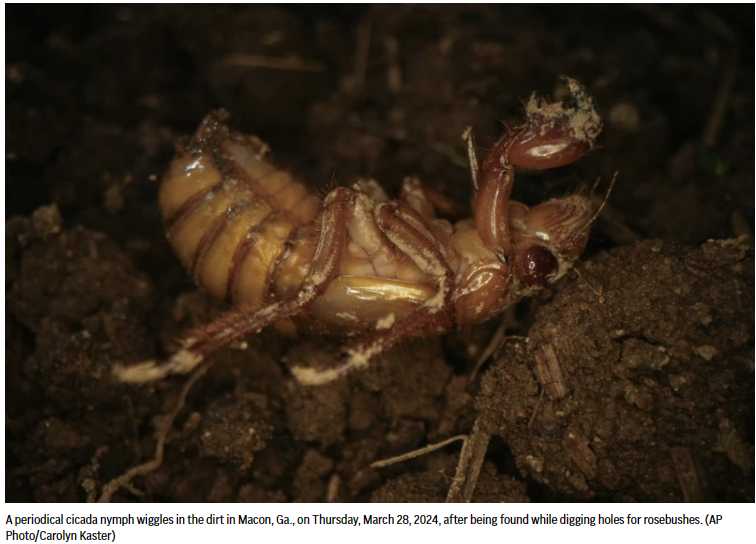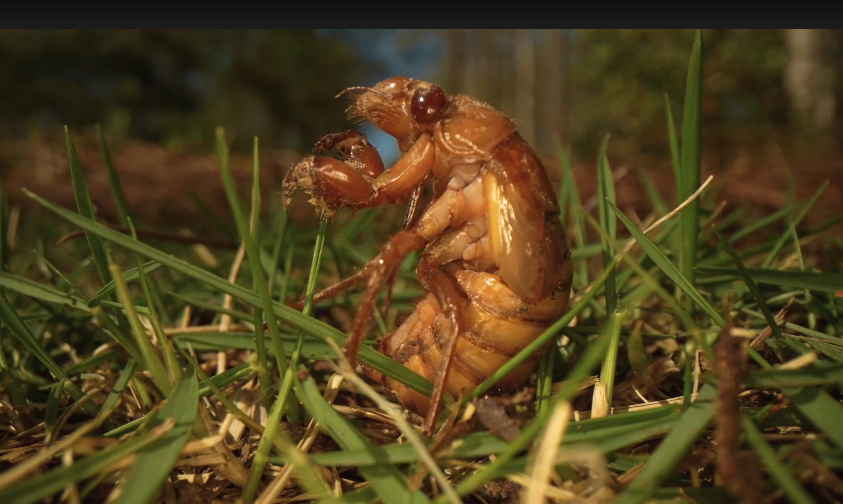By Joke Kujenya
IN A phenomenon not witnessed for centuries, trillions of red-eyed periodical cicadas are poised to emerge this month, and through the year, heralding an extraordinary event that entomologists have dubbed “cicadapocalypse or cicada-geddon.”
These enigmatic insects, known for their synchronized emergence every 13 to 17 years, are set to orchestrate a collective chorus as loud as jet engines, blanketing landscapes and captivating onlookers with their remarkable life cycle.
As the ground warms earlier than before due to climate change, these cicadas, dormant for years underground, are responding to temperature reaching 64 degrees Fahrenheit (17.8 degrees Celsius) by surfacing weeks earlier than historically observed.
Their emergence is not only a natural spectacle but also a reminder of the intricate ecological dance influenced by environmental shifts.
In Macon, Georgia, T. J. Rauls notes that while their presence may seem like a mere curiosity to some, the reality is stranger and more intricate.

These cicadas, equipped with pumps in their heads and jet-like muscles in their rears, feed voraciously on tree roots underground, utilizing a unique mechanism to extract fluid from the xylem.
Their excessive fluid intake results in an unparalleled urinary prowess, with cicadas rivalling elephants and humans in urination flow rates, showcasing nature’s uncanny adaptations.
Yet, amidst this awe-inspiring display, a sinister threat looms – a sexually transmitted fungal disease ravages cicada populations, transforming them into zombies and jeopardizing their reproductive capabilities.
This fungus, with hallucinatory effects on birds, utilize cicadas as unwitting carriers, spreading its spores to infect others in a macabre cycle of parasitism.

And, as trillions of cicadas prepare to emerge across 16 states in the United States of America (USA), including the convergence of two broods not witnessed since the late Thomas Jefferson’s presidency, the spectacle, scientists note, would be both a testament to nature’s resilience and a harbinger of ecological change.
These ancient insects, a consortium of scientists also note, exist long before human civilization, and they reportedly offer a glimpse into a world governed by cyclical rhythms and evolutionary strategies honed over millions of years.
For enthusiasts like T. J. Rauls, humans encountering these cicadas is not merely a curiosity but an exciting and bewildering experience, marking the beginning of a natural phenomenon that transcends human understanding.
As they emerge from the earth to ‘say hellos’ in their prime number years, Rauls notes that these cicadas remind “us of the intricate web of life that surrounds us, where even the most peculiar creatures play vital roles in the embroidery of existence.”
As the anticipation builds for the rate emergence of the billions of cicadas, scientists delve deeper into the intricate relationship between these fascinating insects and the mysterious fungus that manipulates their very behaviour.
So, the cicadas, with their characteristic red-eyes and deafening song, are dubbed cicadapocalypse or cicada-geddon – given that this year’s marks an extraordinary convergence of two distinct broods – Brood XIX and Brood XIII, emerging simultaneously after 221 years.
While fears of a massive overlap of the two broods may seem exaggerated, the spectacle promises to be nothing short of mesmerizing.
Amidst the excitement, researchers continue to unravel the enigma surrounding the Massospora cicadina fungus and its parasitic control over the cicadas.
The fungus macabre tactics, from destroying insects’ genitals to turning them into unwitting carriers of its spores, blur the lines between science fiction and reality as Dr. John Cooley aptly notes: “The fact is actually much stranger than science fiction.”
Despite their grotesque transformation, the infected cicadas, exhibit hypersexual behaviour driven by the fungus, leading to a cycle of mating and spreading of the infection.
Another scientist, Dr. Matt Kasson’s notes that the discovery of amphetamines within the fungal plugs offers a potential explanation for the altered behaviour, although the exact mechanism remains a subject of intrigue.
As the emergence draws nearer, scientists say they are prepared to study infected insects from both broods, aiming to uncover any genetic distinctions between the strains infecting the 17-year and 13-year cicadas, and noting also that, despite their abundance and loudness, cicadas are of harmless nature to humans.
Scientists are also urging humans to contribute to their research efforts via documenting cicada sightings as well as how factors like climate change influence cicada populations and behaviours in general.
Amidst the awe-inspiring phenomenon of cicada emergence, there lies a deeper appreciation of the intricate balance of nature and resilience of these remarkable insects, notes Dr. Jonathan Larson who describes them as “one of America’s coolest insects.” He then urged people to embrace the unique opportunity to witness nature’s spectacle unfold.
At JKNewsMedia, our dedication to delivering reliable news and insightful information to our cherished readers remains unwavering. Every day, we strive to provide you with top-notch content that informs and enlightens. By donating to JKNewsMedia, you directly contribute to our mission of delivering quality journalism that empowers and informs. Your support fuels our commitment to bringing you the latest updates and in-depth analysis. Let's continue to uphold the highest standards of journalism and serve our community with integrity and dedication. Thank you for being a part of the JKNewsMedia family and for your ongoing support.





